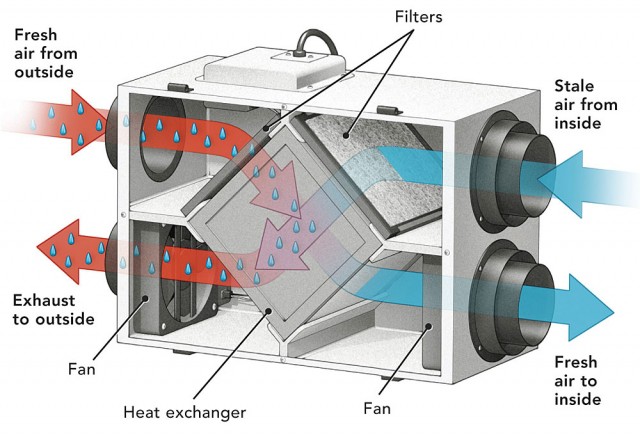The Definitive Guide to HRV Installation in Residential Spaces
Wiki Article
How Heat Recovery Ventilation Enhances Indoor Air Quality and Reduces Power Prices
Heat Recovery Ventilation (HRV) systems play an essential duty in enhancing indoor air high quality while at the same time reducing power costs. By effectively exchanging stagnant indoor air with fresh outside air, HRVs help preserve perfect moisture and decrease pollutants. In addition, their capability to recoup heat from outbound air reduces the stress on home heating and cooling down systems. As energy expenses remain to rise, recognizing the complete capacity of HRV systems becomes increasingly vital for home owners and businesses alike.Recognizing Heat Recovery Ventilation Equipments

Heat recovery ventilation (HRV) systems play an essential function in boosting interior air high quality, specifically in modern-day, energy-efficient structures. These systems are designed to transfer warm from the outward bound stagnant air to the incoming fresh air, thus decreasing energy loss while maintaining suitable temperature degrees indoors. HRVs include a heat exchanger, fans, and ductwork, facilitating the continuous flow of air. By eliminating indoor toxins and presenting fresh air, HRVs help to balance humidity degrees, prevent mold growth, and reduce allergens. The efficiency of HRV systems lies in their capability to recuperate as much as 80% of the warm from the exhausted air, promoting energy preservation while making sure a healthy and balanced interior environment. Their assimilation is essential in attaining lasting living techniques.
The Relevance of Indoor Air Top Quality
Indoor air quality (IAQ) is an important aspect influencing the health and wellness and wellness of residents in any environment. Poor IAQ can bring about numerous health and wellness problems, including respiratory system troubles, allergic reactions, and fatigue. Furthermore, it can aggravate current problems such as asthma. Factors adding to reduced IAQ include pollutants from interior resources like cleansing agents, mold, and poor ventilation. Keeping good IAQ is essential for promoting a safe and comfy living or working room. Efficient strategies to enhance IAQ involve normal monitoring of air top quality, appropriate air flow systems, and reducing using dangerous compounds inside. By prioritizing IAQ, people can guarantee a much healthier environment that promotes productivity and general top quality of life.Power Efficiency Advantages of HRV Solutions
Several homeowners and building managers are significantly identifying the energy efficiency benefits of warm healing air flow (HRV) systems. By transferring warm from tired interior air to inbound fresh air, HRV systems considerably decrease the energy needed for heating & cooling. This process decreases reliance on standard HVAC systems, causing reduced power bills. Furthermore, HRVs aid preserve a well balanced interior environment, protecting against too much home heating or cooling demands. The ability to recover approximately 90% of the warm from outward bound air likewise supports sustainability efforts by decreasing overall energy consumption. Subsequently, HRV systems add not just to cost savings but likewise to a minimized carbon footprint, aligning with the growing Get More Information focus on energy-efficient structure methods.Installment and Maintenance Considerations
The efficient application of warm healing air flow (HRV) systems needs mindful consideration of setup and maintenance variables to assure peak performance. Correct positioning of the HRV device is vital, as it ought to be mounted in a location that takes full advantage of air flow while decreasing sound interruption. Furthermore, ductwork needs to be appropriately sized and insulated to stop power loss. Regular maintenance, consisting of filter replacement and system cleansing, is crucial to secure optimal performance and interior air quality. Proprietors should establish a routine upkeep schedule to identify and attend to potential issues prior to they rise. Partnership with experienced professionals throughout both setup and upkeep phases can enhance the long website here life and effectiveness of HRV systems, ultimately bring about much better interior settings and decreased power expenses.
Real-World Applications and Success Stories
Exploring real-world applications of warmth recuperation ventilation (HRV) systems exposes their considerable effect on interior air quality and energy effectiveness throughout numerous setups. In residential buildings, house owners have actually reported better air top quality, resulting in fewer allergies and respiratory issues. Schools executing HRV systems have noted improved pupil concentration and decreased absenteeism because of much better ventilation. Industrial buildings, such as offices and retail spaces, have experienced lower power prices and raised staff member performance. A corporate office in a pleasant environment accomplished a 30% reduction in energy costs after mounting an HRV system. These success stories demonstrate that HRV technology not just adds to much healthier settings however also provides substantial economic benefits, making it an important financial investment for different industries.Often Asked Concerns
Can HRV Solutions Reduce Irritants in Indoor Air?
The efficiency of HRV systems in decreasing interior allergens primarily rests on their capability to filter and exchange air. HRV Heat Recovery Ventilation. By continuously changing stagnant air, these systems can substantially reduce allergen degrees throughout indoor settings
How Does Humidity Affect HRV System Performance?
Moisture substantially affects HRV system performance; high degrees can result in condensation, reducing performance, while reduced humidity might improve air exchange. Balancing moisture is necessary for optimal operation and keeping interior air quality.Are HRV Equipments Noisy During Operation?
HRV check that systems can create differing noise degrees throughout operation, relying on their style and installment. Some systems operate silently, while others may create visible sound, especially at higher air flow settings or when poorly maintained.What Is the Ordinary Lifespan of an HRV System?

Can HRV Equipments Be Used in All Climates?
HRV systems can be used in numerous environments, but their efficiency might differ - HRV Heat Recovery Ventilation. In severe temperatures, adjustments or supplemental systems might be essential to ensure perfect performance and convenience while preserving interior air qualityReport this wiki page